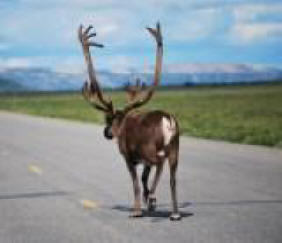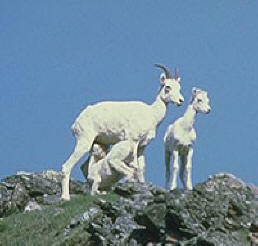Mountain goats are found in the rough and rocky mountain regions of Alaska, throughout the Southeast and along the Coastal Mountains of the Cook Inlet. Populations are generally confined in the areas of the Chugach and Wrangell Mountains. Mountain goats have been transplanted to the islands of Baranof and Kodiak, where they have maintained a steady population. The mountain goat is the only representation in North America of the goat-like ungulates. They constantly migrate to different areas from the alpine ridges in the summer, and to the tree-line in the winter.
Mountain goats occupy remote habitat in North America and were not described in the scientific literature until 1816. They are one of the least-studied large mammals in North America. They are sometimes confused with Dall sheep, but sheep are not found in Southeast Alaska and prefer drier country. The mountain goat (Oreamnos americanus) is the single North American representative of a unique group of mountain ungulates called the Rupicaprinae, or “rock goats.” They are characterized by having relatively short horns and a fondness for living in rugged terrain. Mountain goats are one of two species of all-white, hoofed, large mammals found in Alaska.
Mountain goats are easily distinguishable from Dall sheep by their black horns. These creatures are well adapted for extreme winter conditions and have a long, shaggy winter coat. A crest of long, erect hair up to eight or more inches in length runs along the spine, on the rump, and over the shoulders and neck. Long hairs on the legs give the appearance that the goat is wearing pantaloons. Mountain goats begin shedding their winter coat in June, with adult males and sub-adults shedding-out before females. By July, their soft, sleek summer coat is grown in. When the first winter snows dust the high country in mid-October, mountain goats have fully grown their winter coats again.
The appearance of both sexes is much alike except that males are about 40% larger than females and have differently shaped horns. Adult female goats weigh about 180 pounds, with males weighing 260 to 350 pounds. The horns of an average adult female are equal in length to those of an average adult male but are more slender and bend back more sharply at the tip. Mountain goat hooves are specially designed for climbing in steep, rock, and slippery terrain. A close-up look reveals a hard keratinous sheath and a soft embedded pad that enable goats to gain purchase on the smallest of granite cracks while simultaneously gripping maximum surface area. Mountain goats are both grazing and browsing animals depending on the particular habitat and season of the year. They normally summer in high alpine meadows where they graze on grasses, herbs, and low-growing shrubs. As winter advances, feeding habits generally shift to browsing. Blueberry, hemlock, and lichen can be important winter diet items, but feeding habits in winter center on availability.
The breeding season for mountain goats occurs between late October and early December. Billies (males) may travel considerable distances in search of receptive females (nannies). Mountain goats have a polygynous mating systems, meaning that males will breed with multiple females but not vice versa. Typically, prime-aged males (5-10 years old) do most of the breeding, with some battling among males causing occasional puncture wounds. Adult males usually separate themselves from the larger group except for during the rut. They may form small bachelor groups, especially in summer. Females, on the other hand, tend to stay in groups along with kids and immature animals. This behavior is particularly evident during mid-summer when large nursery bands form. Usually a single kid is born in mid-late May after a gestation period of approximately 180 days. Twinning occurs rarely but is more frequent following mild winters on good range. Nannies seek out rugged, isolated sites prior to giving birth but soon join other nannies with newborn kids to form nursery groups. Kids remain with their mothers until the next breeding season and often for some years beyond. Interestingly, mountain goats will not give birth until they are 4 years of age; this is quite old compared to female moose, black-tailed deer, and caribou. Mountain goats may live up to 18 years, but most live less than 12. Helicopter activities have increased raising concerns about mountain goat responses to helicopter activity. Proposed mines and hydroelectric developments could also make habitat more accessible or adversely affect goat habitat directly.
|








